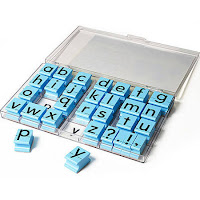Today I'm going to tell you about my absolute favorite game to use in the classroom. I like this game because it allows the students to get up and move! I also love it because it can be applied to so many different content areas.
All you need to masking tape. You will need several rolls. I used one entire roll for the one we did in my classroom last week. I like to use colorful masking tape because it shows up better on the light-colored floors in my classroom.
This year I have noticed that this particular group of students could use a little extra practice identifying teen numbers. A common mistake at the beginning of first grade is mixing up numbers like 13 and 30.
For the teen numbers I made 9 boxes. You want to make pretty big boxes so your students don't run into each other. Then I used the tape to make a different teen number in each box. I wrote the same teen numbers on index cards, folded them in half, and put them in a basket. You will also need a line of tape outside of the box on each side for the two teams to stand on at the start of each turn.
After you've done all the prep work, split your group of students into two teams. I have the teams sit in straight lines on the floor and wait for their turn.
The student sitting in the front of the line on each team goes first. They each stand behind their designated line and wait for the teacher to draw a number. The teacher then draws the number and says it aloud. Then, the student from each team wants to be the first one to find and stand on that number. You can have them hop or walk to the box with that number.
You can also determine if it is a tie and have the students start again. The student who stands on the number first gets to stay up for the next round. The person who didn't get there first sits in the back of their line and waits for their next turn. Luckily, this is a pretty fast-pace game so each student will get plenty of opportunities to play.
Another important rule is that the winner of each round must have both feet completely in the box. These two students (pictured above) made it to the "19" box at the same time. However, the girl has both of her feet inside the box and the boy does not. Therefore, the girl won this round of the game.
I do understand that some classroom teachers like to stay away from competitive games and activities. This game can very easily be modified for that type of classroom. Instead of having two teams and having the students race, you could simply have one student at a time and just make it an activity to see how fast he or she can find and get to the number each time. Either way, it is a fun and engaging way for students to practice a particular skill.
Here is my favorite thing about this activity... it can be used for:
1. letter identification
2. letter sounds/jolly phonics
3. sight words
4. addition and subtraction
5. multiplication and division
and many more!
Another similar activity that I like to do with students is for practicing word segmenting (this is part of our literacy standardized test).
Use masking tape to make a layout like this (below):
This particular set up would be used for practicing three and four sound words. I would have a list of those types of words ready. The list I use has the words mixed up. You can download that document here.
You can also do this with 4 and 5 sound words if you'd like to make this more challenging.
Something else you may notice with this activity is that students' interest will be sparked almost immediately. When students come into the room and they see big boxes of tape on the floor they will instantly start asking questions about it. I always tell my students, "It's a fun activity we'll be doing later today!" They then wait anxiously until they discover this exciting new game. I have had wonderful luck with this game and I hope you enjoy it too! Thanks for reading. Happy Monday! :)
Something else you may notice with this activity is that students' interest will be sparked almost immediately. When students come into the room and they see big boxes of tape on the floor they will instantly start asking questions about it. I always tell my students, "It's a fun activity we'll be doing later today!" They then wait anxiously until they discover this exciting new game. I have had wonderful luck with this game and I hope you enjoy it too! Thanks for reading. Happy Monday! :)























































